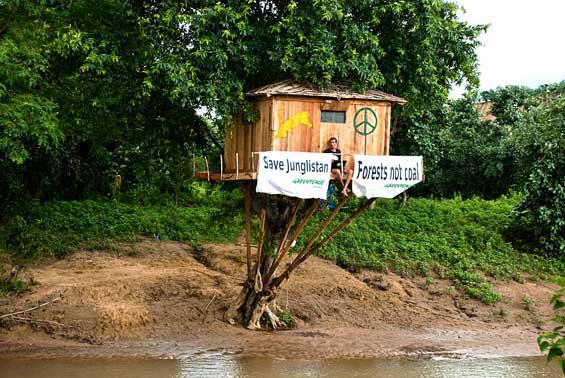Why I Chose To Spend 30 Days On A Tree
Author:
First published in Sanctuary Asia,
Vol. 32
No. 11,
November 2012
 Photograph by Sunny L/Greenpeace.
Photograph by Sunny L/Greenpeace.
This year, India is hosting the UN Convention on Biological Diversity (CBD) in Hyderabad and it angers me that our government seems to be on a path to destroy whatever little biodiversity we have left. More than one million hectares of forests in Central India face the threat of destruction due to coal mining in just 13 (out of 40) coal fields. (Sanctuary, Vol. XXXII, No. 4, August 2012).
In July, I travelled to the Mahan forest in Singrauli, Madhya Pradesh, one of many that face imminent devastation from coal mining. I walked up a hill to get a clear view and saw a vast stretch of forest spreading as far as I could see; to my left was the chimney of an upcoming thermal power plant, rising up like a monstrosity over the forest, foretelling its doom. That power plant is intended to be fired with coal that lies under the Mahan forest. If the government has its way, sooner or later that forest - and the leopards, bears and the occasional tiger or elephant that rely on it - will be replaced by a coal mine. Thats when I decided that the world needs to know what coal mining is doing to the forests of Central India.
So I decided to live for a month on a tree near a coal mine, on the edge of the buffer zone of the Tadoba-Andhari Tiger Reserve in Maharashtra, to bring the worlds attention to a crime that is being perpetrated every single day, unknown to most of us urban Indians. By the time you read this, I will have spent 30 days living on this tree. In the last three weeks, I have felt the thunder of 81 blasts from the Padmapur coal mine, a stones throw away. From my tree, I can also see a new chimney under construction for the extension of the Chandrapur Super Thermal Power Station, which will soon burn even more coal from underneath our forests.
The forest speaks
People often say that we have to speak for the rights of forests and wildlife as they cant speak for themselves. But this forest can speak; I have been listening to its stories every day. I have learnt that a forest has a lot to offer, if only we would make an effort to use and not abuse it. There is a stream that flows five feet (150 cm.) from my tree, from where I source my drinking water; this stream has been a water source for humans and wildlife for hundreds of years. A shepherd tells me that further downstream, the natural flow has been diverted to pass through the coal mine so that they can use it to drain their waste water, turning it into a filthy gutter just half a kilometre away. I also see claw marks of sloth bears on tree trunks, spot the trails of a rock python, cobra and other snakes, and see wild pigs and more species of birds than I have ever sighted in my life. Thats a snapshot of the biodiversity in the hectares and hectares of forest which are at stake.
Our government is destroying all this for coal in my name, in your name. They will turn to us and say “You want electricity, thats why the forests had to go!"
So thats the reason I climbed up this tree, to gather support from lakhs of Indians that I will take to our Prime Minister at the CBD in Hyderabad. I will ask him to put a moratorium on all new forest clearances for coal mines. I will tell him that Indians want “forests, not coal."
Sanctuary readers can sign the petition to the Prime Minister at www.junglistan.org
by Brikesh Singh, First appeared in: Sanctuary Asia, Vol XXXII No. 5, October 2012


 Photograph by Sunny L/Greenpeace.
Photograph by Sunny L/Greenpeace.